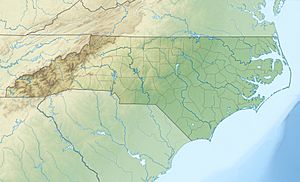Rose Creek (Haw River tributary) facts for kids
Quick facts for kids Rose Creek |
|
|---|---|
|
Location of Rose Creek mouth
|
|
| Other name(s) | Tributary to Haw River |
| Country | United States |
| State | North Carolina |
| County | Rockingham Guilford |
| Physical characteristics | |
| Main source | divide between Rose Creek and Reedy Fork Apple Pond about 1.5 miles west of Osceola, North Carolina 768 ft (234 m) 36°13′21″N 079°38′16″W / 36.22250°N 79.63778°W |
| River mouth | Haw River about 1 mile southwest of Williamsburg, North Carolina 650 ft (200 m) 36°16′06″N 079°36′28″W / 36.26833°N 79.60778°W |
| Length | 3.52 mi (5.66 km) |
| Basin features | |
| Progression | northeast |
| River system | Haw River |
| Basin size | 5.69 square miles (14.7 km2) |
| Tributaries |
|
| Waterbodies | Apple Pond |
| Bridges | Chrismon Road, Poley Road, Candy Creek Road |
Rose Creek is a small stream, about 3.52 mi (5.66 km) long, located in Guilford and Rockingham County, North Carolina. It's a "2nd order tributary" which means it's a stream that flows into another stream, which then flows into a larger river. Rose Creek eventually joins the Haw River.
Contents
The Journey of Rose Creek
Rose Creek begins its journey in a place called Apple Pond. This pond is in Guilford County, near a natural high point that separates Rose Creek from another stream called Reedy Fork.
From Apple Pond, Rose Creek flows towards the northeast. It travels through both Guilford County and then into Rockingham County. Finally, it meets the larger Haw River. This meeting point is about 1 mile southwest of a town called Williamsburg, North Carolina.
Understanding the Watershed
A watershed is like a giant bowl or a drainage area. It's all the land where rain and snowmelt collect and drain into a specific river, lake, or stream. The Rose Creek watershed covers an area of about 5.69 square miles (14.7 km2).
- Rainfall: This area gets a good amount of rain each year, about 46.2 inches. This rain helps keep the creek flowing.
- Forests: A big part of the watershed, about 39%, is covered by forests. These trees are important because they help filter the water and keep the soil from washing away.
Special Natural Areas
The land around Rose Creek is home to some important natural areas. Experts who study nature in Rockingham County have found a special spot within the Rose Creek watershed called the Williamsburg Alluvial Forest.
- Williamsburg Alluvial Forest: This is a very important site for the county. An "alluvial forest" is a type of forest that grows on rich, fertile soil deposited by a river during floods. These areas are usually very green and full of life.
- Types of Forests: This special forest contains examples of two main types:
- Piedmont Alluvial Forest: This is the forest type that thrives in the rich, moist soil near rivers in the Piedmont region of North Carolina.
- Mesic Mixed Hardwood Forest: This type of forest has a mix of different kinds of hardwood trees (trees that lose their leaves in winter) that prefer medium levels of moisture.
These forests provide homes for many plants and animals and help keep the creek's ecosystem healthy.
Images for kids





